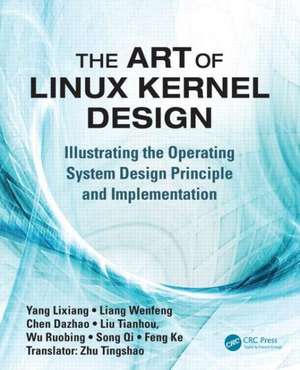The Art of Linux Kernel Design: Illustrating the Operating System Design Principle and Implementation
Autor Lixiang Yangen Limba Engleză Paperback – apr 2014
Difficulty in understanding an operating system (OS) lies not in the technical aspects, but in the complex relationships inside the operating systems. The Art of Linux Kernel Design: Illustrating the Operating System Design Principle and Implementation addresses this complexity. Written from the perspective of the designer of an operating system, this book tackles important issues and practical problems on how to understand an operating system completely and systematically. It removes the mystery, revealing operating system design guidelines, explaining the BIOS code directly related to the operating system, and simplifying the relationships and guiding ideology behind it all.
Based on the Source Code of a Real Multi-Process Operating System
Using the 0.11 edition source code as a representation of the Linux basic design, the book illustrates the real states of an operating system in actual operations. It provides a complete, systematic analysis of the operating system source code, as well as a direct and complete understanding of the real operating system run-time structure. The author includes run-time memory structure diagrams, and an accompanying essay to help readers grasp the dynamics behind Linux and similar software systems.
- Identifies through diagrams the location of the key operating system data structures that lie in the memory
- Indicates through diagrams the current operating status information which helps users understand the interrupt state, and left time slice of processes
- Examines the relationship between process and memory, memory and file, file and process, and the kernel
- Explores the essential association, preparation, and transition, which is the vital part of operating system
This text offers an in-depth study on mastering the operating system, and provides an important prerequisite for designing a whole new operating system.
Preț: 350.22 lei
Preț vechi: 507.87 lei
-31% Nou
Puncte Express: 525
Preț estimativ în valută:
67.01€ • 70.16$ • 55.45£
67.01€ • 70.16$ • 55.45£
Comandă specială
Livrare economică 15-29 martie
Doresc să fiu notificat când acest titlu va fi disponibil:
Se trimite...
Preluare comenzi: 021 569.72.76
Specificații
ISBN-13: 9781466518032
ISBN-10: 1466518030
Pagini: 534
Ilustrații: 309 black & white illustrations, 1 black & white tables
Dimensiuni: 191 x 235 x 28 mm
Greutate: 0.9 kg
Ediția:1
Editura: CRC Press
Colecția Auerbach Publications
Locul publicării:Boca Raton, United States
ISBN-10: 1466518030
Pagini: 534
Ilustrații: 309 black & white illustrations, 1 black & white tables
Dimensiuni: 191 x 235 x 28 mm
Greutate: 0.9 kg
Ediția:1
Editura: CRC Press
Colecția Auerbach Publications
Locul publicării:Boca Raton, United States
Cuprins
From Power-Up to the Main Function . Device Initialization and Process 0 Activation. Creation and Execution of Process 1. Creation and Execution of Process 2. File Operation. The User Process and Memory Management. Buffer and Multiprocess Operating File. Inter-Process Communication. Operating System’s Design Guidelines.
Notă biografică
Lixiang Yang is an associate professor of the University of Chinese Academy of Sciences. His research interests include operating systems, compilers, and programming language. Recently, he and his team successfully developed a new operating system that aims to fundamentally solve the problem concerning the intrusion of illegal programs into computers. They set up two websites for hackers to perform the intrusion attack test. These addresses are ftp://203.198.128.163/and ftp://114.242.35.6/.
Descriere
This book uses the real source code of a multi-process operating system (OS) as the blueprint and its actual running operation as the main thread. It uses the concept of "master-slave mechanism" and provides more than 300 figures, illustrating the complex relationships within the OS. Divided into two sections, it provides detailed insight on the complete process from booting up to system idling. The second part uses a few carefully designed real-life user operations as study cases to explicate important OS concepts.
